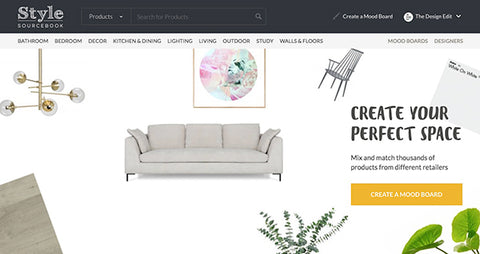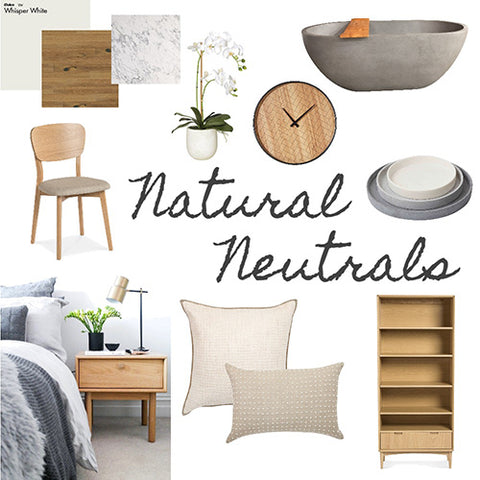If you're looking to build, renovate or simply redecorate, you're probably overwhelmed by the mountain of decisions in front of you and the sheer volume of options available! When we built our house as owner-builders, every design decision felt like an ordeal…I knew what I liked when I saw it, but couldn't visualise whether everything I chose would work well together and create a cohesive look.
Everything became much easier when I started putting together mood boards - they allowed me to experiment with different styles and products before making a commitment, and gave me confidence in my decision making. Now that our home has been built and we're well and truly settled in, I'm happy to report that we love the final product, and even now, still stop to admire particular finishes or products that we chose.
Here are my tips on creating an interior design mood board for your next design or decorating project. You can create a specific board for each room in your home, or you may want to start off with just one board for your whole project that centres around a general look and feel, such as our Natural Neutrals board below.
Happy Medium
The first step is to choose your mood board medium - you can go with something traditional, such as pinning physical magazine cut-outs onto a cork board, or sticking them inside a notebook, or you can create a digital board using Pinterest, design software, or a mood board creator website such as Style Sourcebook.

Image source: Style Sourcebook
It's entirely up to you as both options have their pros and cons. I'm a fan of old school pen and paper, and I still carry around a physical diary in my handbag for recording appointments rather than putting them into my iPhone - having said that, the beauty of a digital mood board creator like Style Sourcebook is that you can size things proportionately and get a better feel for how a space will actually look in real life. You might love that emerald green couch when it's in a small magazine clipping, but once you enlarge it on your digital mood board to be bigger than the armchair and coffee table, you may find that the colour overpowers the room too much for your liking. The digital option also allows you to make changes quickly and easily, which is priceless when you're time-poor (which if you're building or renovating, you definitely are!).
On the other hand, the beauty of going physical is that you can include actual sample swatches of curtains, carpets, upholstery fabric, wallpaper etc so that you have a sense of texture and true colour on your board.
Decide on Your Core Style
Ask yourself what main style you want to achieve eg. Country, Scandinavian, Eclectic, Minimalist, French Provincial etc… This step is crucial because it will narrow down your other options significantly, and will ensure you stay focused and disciplined when selecting your pieces. There are many interior design styles that blend well together too, hence the birth of looks such as Rustic-Industrial and Japandi, so deciding on and sticking with a core style may be a little harder than you expected!
Natsumi Bedside Table by The Design Edit
Before you lock in your chosen style, have a browse through Pinterest and Instagram so that you can visualise and confirm it. Even if you're pretty sure of what you like, after browsing through hundreds of images you may be surprised to discover that you actually prefer a different look to what you expected. We originally thought we wanted a modern Scandinavian look, but then realised that we really love, is a Scandi-industrial look, with a lot of Oak and matte black finishes.
Another thing to do before you decide on your core style is to think about whether it's practical for your space, and whether or not it will stand the test of time. There may be a design trend that you're crazy about right now, but consider whether or not you will still love it in 5 years' time, or whether you'll outgrow it long before then.
Colour Me Pretty
The next step is to decide on your colour palette, including your dominant neutral colours and any accent colours. You probably already have a fair idea of your preferred colours, but if you pop down to a hardware store to play with the paint sample cards, you'll be able to better visualise which colours go well together.
Once you've chosen your colour palette, carry paint sample cards, fabric swatches or other visual cues with you when you're deciding on other pieces so that you have something you can refer to. Don't feel overly restricted or that you need to find items that match exactly - the point of the colour palette is make sure any pieces you buy complement your colour scheme, not that everything is an identical match.

Image source: Dulux Australia
Hunt for Inspiration
Now for the fun part - browsing through Pinterest, Instagram, interiors blogs, magazines and online and physical stores to pick out the finishes and products you love. Having already decided on your core style and colour palette, you should now be free to instinctively pick out any pieces that catch your eye, and add them to your mood board.
Layer images starting with the largest pieces first, moving onto smaller items of décor and soft furnishings after the key items have been chosen. If you're redecorating a room rather than starting with a blank canvas, remember to add your existing pieces into the mood board as well to make sure your old and new pieces complement each other.
Bring Me to Life
While your mood board will continue to change as you play around with different combinations and swap out pieces to create your perfect look, you should aim to lock in some choices as soon as you're ready. The more decisions you make, the easier the next ones will be, as you compare potential new pieces with the existing ones on your board and assess how well they gel together. Once you've made decisions on carpet, upholstery, floorboards etc, request as many swatches and offcuts as you can, so that you have physical samples of the real thing. You can then refer back to these samples when making other decisions.
While you want everything to be cohesive, you don't want everything to be overly uniform. Take a look at your mood board and ask yourself honestly if you have too much of a certain colour, texture or pattern as you may need to pare back.
Technically there is no right or wrong when it comes to creating your mood board, it's simply a tool that you can use to guide you along in your interior design decisions, and help you develop and adhere to your style. So don't be scared, have fun with it and good luck!
Whisper White paint by Dulux
Blackbutt Engineered Oak Flooring by Plantino Native Royale
Statuarietto Marble Benchtop by CDK Stone
Medium Butterfly Orchid by Rogue
Bruce Wall Clock by Amalfi
Natural Stone Freestanding Bath by Just in Place
Alva Dining Chair by The Design Edit
Mortar Trays by Amalfi
Natsumi Bedside Table by The Design Edit
Double Boucle Cushion by Cafe Lighting + Living
Lila Cushion by Cafe Lighting + Living
Ingrid Bookcase by The Design Edit
Banner image source: Style Sourcebook


